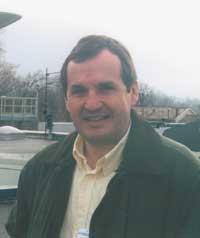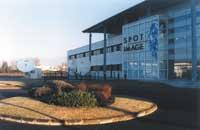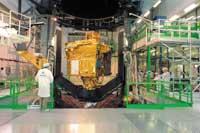Suletino Michel Duplaa investigating satellites
He spent his youth in Maule and went to Pau University to study mathematics. He spent four years in Pau and, since he did not want to be a teacher, decided to go to Paris, to the high-level electricity school. In two years he obtained a diploma. He made a small mili and started looking for work. He didn't want to get too far from home. Therefore, starting from Maule, he worked in Bordeaux, Toulouse in Occitania and Bilbao. At that time, the Centre National d’Études Spatiales (CNES) had just opened numerous offices in Toulouse and, after an interview, began working on it. It has been twenty-nine years since then and continues to work there. We visited the Suletino Michel Duplaa in Toulouse and had the opportunity to know its place of work and its functions.
What do you do at the CNES in Toulouse?

The largest CNES centre is in Paris. In addition, we have four other centres: one in Guyana, where the Ariane rockets are thrown, the second in Evry, the third in the city of Airsur-l’Adour and the last in Toulouse.
In this center of Toulouse research work is carried out for the development of new satellites. In case you have to make a new application, we collect the needs of customers and make a proposal based on a study. Then, we began to investigate all parts of the satellite, especially the most difficult parts. From these results we obtain the specifications of the satellite. Once the satellites are built, they are sometimes delivered to the client for conservation, although in most cases it is the CNES itself in charge of controlling these devices. That is, the first operations when launching the satellite are carried out by the CNES, as well as the commissioning and maintenance of the satellite.
On the other hand, data from observed satellites on Earth are treated and archived in Toulouse in two other companies of the same center: SPOT-Image and CLS-Argos. The fifth of the Spot satellite family has been in orbit this month.
How many workers are you in the center of Toulouse?
At the headquarters of Tolosa we are 1,700 workers, 70% engineers.
What is your job at this great company?
We need special data collection, correction and image measurement systems. My team works on satellite projects, in the preparation of new ground systems. I care and direct your obligations. I have done several projects in this field and am currently working on the scientific satellite study team.
How many parts do satellites have?
The main parts are the platform and payload. Basic satellite devices are part of the payload and are associated with the platform structure. The platform also has tools to laxate and move the satellite. We also place tools to send messages to the ground, antennas, heat meter and central computer.
How are satellites made?
The diversity of parts of a satellite makes several companies participate in the same project. However, a major company is needed to build the satellite. This company buys or manufactures parts and then assembles all parts to form the satellite.
On the other hand, do not forget that once the satellite is broadcast you can break. In fact, from the Sun it receives enormous force. Therefore, before its implementation in space, two or three molds of each of the satellites are made. The satellite molds are inserted into an apparatus where technicians measure the useful, temperature, movements... Subsequently, depending on the needs, the mold changes to correct the weaker parts.
Do you need special technology?

Yes, to meet the aforementioned requirements special devices are required. Tests must be performed before it is placed on the satellite we use on the ground.
After building satellites do you track?
Once the satellite is approved, we get involved. We take it with a wide plane or boat to the rocket center and prepare the launch. We conducted a final exam and authorized the launch.
How do you take care of satellites?
Since the satellite is valid, you always have to take care of it. When taken to a station, it emits a remote message and the satellite control center analyzes the message parameters. If an error occurs, technicians try to clarify and fix the problem. Orders are then sent to the satellite.
Are there differences between army satellites and civilian satellites?
There are no big differences, as satellites are made the same way. However, the devices are not the same. The military, for example, wants to see better the details of the Earth and the civilian satellites have no permission to see them. In the construction and use of a satellite for the army information is not transmitted abroad. Anyone who knows this information should be mute.
Why do you mainly use satellites?
Now satellites are used in telecommunications, to track some people, to care for the Earth and the atmosphere, to predict time, to investigate other planets and everyone...
And how and to what extent do satellites and their users care for us?
Satellites see any area of the earth. Therefore, they are a good tool to look at the margins, they offer data to know better the time and facilitate cars and trucks a better driving on the roads. It can be said that satellites have good services, but the user must use these tools properly and directly.
Do you sell satellites? To whom? And for what?
CNES does not sell satellites. The prestigious companies Astrium and Alcatel Space do so in Europe. The best market is telecommunications, but now sales have declined due to the economic crisis. In addition, some villages buy satellite observers to care for the corners of the village.
How long do satellites normally last?

Satellites that climb 800 kilometers or a little less from the Earth last 5 years. They are used to look at Earth. Television or telecommunications satellites are in an orbit of 36,000 km. Its duration is longer, about 10 years.
What do you do with them as the satellites age?
If the satellite is abandoned, it slowly melts and enters the atmosphere about a hundred years. On the other hand, from Earth we cannot order the satellite to fall. Many times we installed it in a parking lot in orbit to prevent other satellites from hitting.
What areas did you want to improve on satellites for the future?
As in other areas, we want to reduce costs. But we must also lighten the weight of satellites, as the cost of launch is associated with weight. We are now reducing satellites.
Buletina
Bidali zure helbide elektronikoa eta jaso asteroko buletina zure sarrera-ontzian











